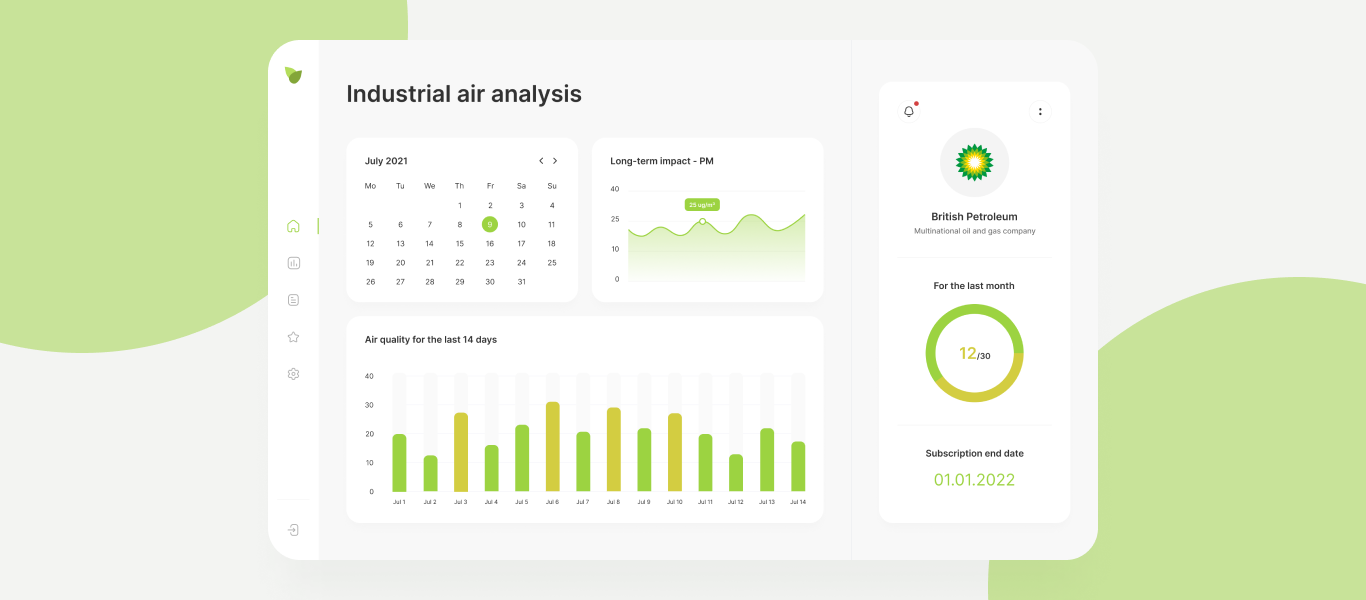Select a language

Enterprise emission control system
Enterprise emission control system
Today we want to share the details of our NewEra project. This project belongs to the field of Ecology. Caring for the environment is an integral part of any business. In the 21st century, it is necessary to control and reduce emissions using smart systems. NewEra allows enterprises to minimize emissions of harmful substances into the atmosphere both from one device and from the enterprise as a whole.
Project goal: to create from scratch a web application for calculating the current number of emissions of harmful substances in the atmosphere, as well as the functionality for developing recommendations and a checklist of actions that the enterprise should take to minimize the calculated emissions.
We divided the process of creating a web application into 3 sub-stages.
1. Analysis and preparation
1.1. Analysis of the distribution area of this application, market analysis and analysis of application use.
1.2. Discussion with the customer of the technical task.
1.3. Creation of integrated gaps and MVP version of the product.
1.4. Description of the technical task, creating a flow application in mirro
1.5. Designing the application structure
1.6. Choosing the development team (2 front-end developers, 2 back-end developers, QA-engineer, designer, project manager, business analyst).
1.7. Building processes within the development team. It was decided to use the p3express framework. And build the development process itself in light scrum mode with two-week sprints. This combination allowed us to distribute the issue backlog according to the MVP plan.
1.8. Building diagrams (use cases, classes and data types, sequence, component)
1.9. Filling out a brief for design development. Transferring the assignment to design development. Creation of mockups for testing design models for a focus group. Transfer of the project design for approval.
That is, as a result of this stage, we have ready-made requirements for the project, team, design project, application structure, and documentation. All necessary preparations for the development process are now complete. We can start developing backend, fronted parts and testing.
2. Development process
2.1. Creation of environments for development. It was decided to use a 4-tiered architecture, DTMP tier cascades. The environments were deployed to GitLab CI / CD + AWS ECS bundles
2.2. Backend part:
- Building a DTO Application
- Creating API documentation
- Creating a database and storing application data in it
- Service connection for storing statics
- Connecting Authentication Service
- Creation of a service for working with data on the enterprise and air emissions
- Stripe plan integration for in-app billing
- Balancer connection
- Writing Integration Tests
- Running load tests
Technologies: AWS dynamodb, AWS App Sync, Node.js, Stripe billing
2.3. Front-end:
- Creating a component library
- Building the application infrastructure
- Connection to identification service
- Development of the main dashboard, which indicates the emissions of pollutants into the atmosphere
- Building graphs and charts
- Development of a map of enterprises, which indicates the main divisions where emissions occur
- View emissions from a specific enterprise
- Development of recommendations for the regulation of enterprise emissions
- Implementation of payment systems for subscriptions for the use of an emission control system
- Writing unit tests for the front end
Technologies: React.js, React charts, Apollo client, Stripe billing, AWS Cognito
2.4. Writing auto tests for the application, testing tasks on time, and the risk of testing after the development phase.
The result of this stage is a ready-made web application with the necessary functionality for successful work and business. The finished emission control system has been tested. The error-free version is ready to be handed over to the customer.
3. Completion of the development process and support
3.1. Preparation of the release version of the application, SEO audit, optimization, DNS connection
3.2. Release of the production version of the project, making an announcement in social networks and an advertising campaign
3.3. Transfer of all keys, accounts from the production version to the customer
3.4. App support
3.5. Development of a plan for the further development of the project (updates, addition of functionality, improvement of analytics indicators)
As a result, the application is ready and handed over to the customer. Our team is ready to continue working on supporting the application, as well as its development. The current version is already generating revenue for the customer. But with optimization, adding functionality, you can increase the income from the operation of the emission control system.
